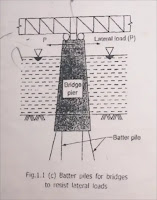Pile Foundation
Any building structure (residence building, industrial building, bridge construction, etc) every structure stand on a foundation, and in civil engineering number of type of foundation is large. Today in this civil experience article we are going to explain about Pile Foundation in detail which you do not want to miss so read carefully and share with friends, Don’t miss join us.
What is Pile Foundation?
A pile is a slender structure member of structural components made of steel, timber, concrete, or any composite material as required. A pole is either driven into soil or cast in situ at the site of construction by excavating a hole and filling it with concrete.
In some cases, the strata of stable good bearing capacity of the soil are not available at shallow depth, the foundation of the structure building has to be taken deep with the purpose of attaining a bearing stratum that is suitable in all respects.
The most usable and common form of the deep foundation is listed below
- Pile foundation
- Cassions or we’ll foundation
- Cofferdam
Pile foundations are intended to transmit structural loads throughout zones of pore soils to a depth where good bearing capacity soil at desired capacity is available to transmit loads.
Piles are somewhat similar to columns in that loads developed at one starting point of the pile and transmitted to another lower end, but the pile obtains lateral support from the soil surrounding the pile so that there is no concern with regard to buckling and, it is in this respect they differ from columns.
Piles are relatively long. The piles may be driven or placed or cast vertically or with batter. A pile foundation usually consists of a number of piles, which together support a structure.
Uses of Piles or Necessity of Pile Foundations
Pile foundations are preferred in the following situations.
- When the load of the superstructure is heavy and its distribution is uneven then pile foundation is adopted.
- Pile foundation is more suitable where the topsoil has poor bearing capacity.
- When the level of the subsoil is high we need to pumping of water from the open trenches to carry out a shallow foundation which is difficult and also uneconomical.
- Pile foundation is suitable for the location of construction has high fluctuations in water table level area.
- In some areas where timber material is too costly or timbering to the trenches is difficult than adopting of pile foundation is more workable.
- The structure is situated on the seashore or river bed, where there is a danger of scouring the action of water.
- Pile foundations are suitable when canal or deep drainage lines exist near the foundations.
- The topsoil is of expansive nature.
- Pile foundations are more suitable for the foundations of transmission towers, offshore platforms that are subjected to uplift forces.



Advantages of Pile Foundation
Some of the benefits of using a pile foundation can be listed as follows
- Pile foundation construction is advantageous when the foundation has to be drilled through hard rocks or tough surfaces.
- Pile foundation can be pre-ordered as well as customized according to site requirements.
- Pile construction is suitable for deep installations and is long-lasting.
- It facilitates reduced construction time.
- Pile foundation uses are desirable even for wetland constructions and for all sizes of land construction.
Factors Affecting Selection of Pile Foundation Types
Lots of factors affecting during the selection of pile foundation type some important and major factors we explain below in civil experience website.
The following factors should be considered while selecting the type of pile.
- Nature of Structure
- Loading Conditions
- Availability of Funds
- Availability of Materials and Equipment
- Type of soil and its properties
- Groundwater table
- Self-weight of the pile
- Durability of pile
- Pile foundation cost
- Pile foundation maintenance cost
- Length of Pile required
- Number of Pile required
- Case study of an adjacent building
- Facilities available for Pile driving
- Difficulties in Pile driving
- Adaptability to varying lengths
- Presence of acids and other materials in the soil that would injure the pile
- Erosion of soil near the structure
Nature of Structure
- For the structures on land, the driven and cast-in-place Piles are usually the cheapest for moderate loadings and unhampered site conditions.
- For the foundations of the wharf – structures and jetties on the seashore, the driven Piles or driven and cast-in-place cased piles area preferred.
- In case of Piling is to be done very near to some existing structure, open-ended tube piles or H-pile may work out to be a good choice.
- Piles used to support marine structures or structures above open water should be precast type.
- The Jacked piles are suitable for underpinning existing structures.
- For Very heavy structures, large-diameter bored piles are the most economical type.
Ground conditions
- If the subsoil consists of silt on alluvium for appreciable depth, the pile will act as a friction pile. Depending upon the load, suitable piles such as Vibro pile. Vibro – expended pile or a tapered pile may be used in such conditions.
- In case the grOund is very weak or loose and it is intended to use cast-in-situ Pile, the casing will be required to prevent the inflow of soil into the pile hole. In adverse conditions, where the groundwater flow is strong, a pile With permanent casing should be used. Alternatively, Precast Piles may be used.
- In case the soil strata are comparatively firm uncased cast – in – situ piles or precast piles may be selected.
- For reducing the length of pile in the firm strata, the pedestal pile will be more effective.
- In some situations where it is necessary that the pile should penetrate into rock for some depth, H-pile may work out to be a good selection.
- In case the soil is firm clay, drilled piles with or without an enlarged base may work out to be an economical choice.
Durability of Pile
- In situations where there is the possibility of the soil being chemically aggressive, high-quality precast concrete piles should be selected.
- Timber piles are not suitable for marine structures as they are likely to be affected by borers or insects.
- Type of Timber piles may work out to be economical if they are used for the foundation of timber trestles structures with moderate loads or if the piles are to be used for protecting concrete docks, etc.
Pile Foundation Cost
- While selecting a particular type of pile, the cost of the pile, cost of driving, cost of maintenance of pile, and availability of funds should be given due consideration.
Availability of Materials and Equipment For Pile Construction
- It is obvious that if the raw materials for pile construction are expensive then the Pile foundation cost will also be expensive.
- Same as if the construction equipment are costly or rant is too high then the final cost of pile foundation also goes higher.
Some Important factors affecting pile selection points are listed below
- The selection of the material of the pile would depend upon the magnitude of the structural load. For light loads, timber piles can be used while for heavy loads, only steel or reinforced concrete piles can be considered for work of pile foundation construction.
- If the site is situated in a very busy and crowded area with structures already constructed in adjacent areas, only small or non-displacement piles have to be used from considerations of noise, vibration, and ground displacement.
- In loose to medium sand conditions, displacement piles help compact the soil, while in clay soil, the use of displacement piles may result in the having of the soil. Hence, in clayey soils and dense sands, non-displacement piles are preferred.
- Driven piles are unaffected by groundwater while in bored piles, concreting has to be carefully monitored when the construction is being carried out below the water table.
- There are limitations to the length of piles of different types.
-
Pile Type Maximum pile Length Approximate Design Load Timber pile 20 m 300 kN Bored concrete pile 30 m 900 kN Bored concrete pile 45 m 900 kN Steel H or Pipe pile Unlimited 1000 kN - The durability of the pile depends on the pile material and the environmental condition. Timber piles are liable to rot when subjected to alternate wetting and drying. If sulfates are present in the soil, concrete piles are likely to deteriorate in strength. Steel is likely to be corroded by the salts. The selection of pile materials must be made keeping in mind any such condition. Alternatively, suitable treatment must be given to the pile material to protect it from damage.
- If there is more than one alternative for the type of pile that can be used in a given project, comparative installed costs must be worked out and the most economical alternative chosen. In many cases, the cheapest form of pilling may not necessarily result in the cheapest pile installation per meter length. The cost of the pile load test has also to be added to the installation cost while working out the overall cost.
FAQ 1: What is Pile Foundation?
A pile is a slender structure member of structural components made of steel, timber, concrete, or any composite material as required. A pole is either driven into soil or cast in situ at the site of construction by excavating a hole and filling it with concrete.
FAQ 2: Uses of Piles or Necessity of Pile Foundations
When the load of the superstructure is heavy and its distribution is uneven then pile foundation is adopted.Pile foundation is more suitable where the topsoil has poor bearing capacity…read more
FAQ 3: Advantages of Pile Foundation
1. Pile foundation construction is advantageous when the foundation has to be drilled through hard rocks or tough surfaces…2. Pile foundation can be pre-ordered as well as customized according to site requirements…3. Pile construction is suitable for deep installations and is long-lasting.4. It facilitates reduced construction time…5. Pile foundation uses are desirable even for wetland constructions and for all sizes of land construction…
FAQ 4: Factors Affecting Pile Foundation Cost
While selecting a particular type of pile, the cost of the pile, cost of driving, cost of maintenance of pile, and availability of funds should be given due consideration.
FAQ 5: Factors Affecting Durability of Pile
1. In situations where there is the possibility of the soil being chemically aggressive, high-quality precast concrete piles should be selected…2. Timber piles are not suitable for marine structures as they are likely to be affected by borers or insects…3. Type of Timber piles may work out to be economical if they are used for the foundation of timber trestles structures with moderate loads or if the piles are to be used for protecting concrete docks, etc…


